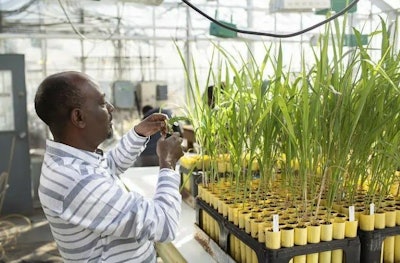
For the past 10 years, Feed the Future Innovation Lab for Collaborative Research on Sorghum and Millet, more commonly known as theSorghum and Millet Innovation Lab (SMIL), is actively involved in developments for the betterment of agriculture and humanity.
It has developed scientific advancements along the value chains of these two crops, and avenues to help those crops become more resilient and accessible in some of the world’s economically poorer nations. It has developed strong relationships with agricultural producers and scientists around the world. It has also developed the minds of students to become leaders in the global agricultural community.
What is SMIL?
Nat Bascom, assistant director of SMIL, explained the origins of SMIL, stating that theU.S. Agency for International Development(USAID), wanted to build global research teams, including one for a sorghum and pearl millet.
Kansas State University(KSU) submitted a bid to be the management entity for SMIL, “and we are thankful and honored to be accepted to take that on,” said Bascom.
After KSU was selected, the staff went out to find research for development proposals that SMIL would fund. They started with about 60 concepts, and narrowed that list down to 15-18 research projects, in Niger, Senegal, Ethiopia and Haiti. And while SMIL is headquartered in Kansas, researchers are from all those countries through a collaborative effort with researchers from other universities, both in the U.S. and abroad.
“We’re working in plant breeding, leveraging in the genomics-assisted breeding platforms with the traditional programs, trying to improve sorghum and pearl millet varieties and hybrids for use in those countries. We also look at the production systems aspect and the food product side,” said Bascom.
“We’re just kind of this global hub for all things sorghum and pearl millet. It’s really exciting, because you get these global teams working on the crop, and it raises the research, raises the commercialization of sorghum and pearl millet for the benefit of the whole globe.”
In the past decade, Bascom estimates that about $30 million has been invested in SMIL research and development programs.
Why sorghum and pearl millet?
Although Bascom said some of the research “spills back” to the U.S. producers, much of SMIL’s efforts are focused on those poorer African nations.
两种作物起源于非洲,因此,他们grow better in that climate than other crops. Sorghum originates from Ethiopia and southern Sudan, Bascom said, and pearl millet originates from west Africa.
“Those two crops are your most drought-resistant cereal crops, really in the world, and we estimate about 500 million people depend on those two crops for their day-do-day food security and nutrition, so they’re real essential parts of the food system for many people,” he said.
He also believes the drought-tolerant crops have a lot of untapped potential as an alternative to more commonly used feed crops, such as corn.
While scientists have developed corn varieties that are more drought resistant, those advancements may not be enough.
“There’s kind of a limit to how far they can go, so I think we’ll kind of get to a tipping point to where sorghum and pearl millet will almost have to come back in and replace corn as either we get extreme temperatures and heat, or we just don’t have the rainfall or irrigation capacity,” Bascom said.
“Sorghum and millet really offer producers some more options, and I think if we could get it more into the hands of millers and the feed industry, I would think that the livestock fattening yards and the dairy industry could really benefit.”
Some success stories
When asked about what he thought were some of the greatest accomplishments through SMIL, Bascom thought of several.
- A SMIL-affiliated researcher fromPurdue University, Tesfaye Mengiste, led a study to help find a gene that would makesorghum resistant to anthracnose, a kind of mold that can be problematic in wetter climates. The gene was discovered, and the result has been an improved seed offering up to a 40% yield gain. That improved seed, namedMerera, is now registered in Ethiopia, and SMIIL is working to get it “scaled out to more farmers.”
- A sugarcane aphid-resistant variety of sorghum has been developed, which Bascom estimated has saved the U.S. industry “a couple hundred million” dollars as a result. The variety was also credited with saving the sorghum crop in Haiti after a devastating year in 2017.
- SMIL科学家,Hannatou穆萨Oumaro领导researcher at the National Institute of Agronomic Research of Niger, developed a pearl millet seed ball technology, that can be produced at the household level. About 10 millet seeds are placed together in this ping pong sized ball which has soil, ash, and organic fertilizer and can be planted “dry” before the rain comes. It helps with the planting process – which is all done by hand in those regions and therefore labor-intensive. It has also led to a 15-20% yield improvement.
Bascom and Benjamin Kohl, SMIL program administrator, agree, however, that possibly the biggest achievement has been the opportunities that have been given to students to apply their expertise and grow as agricultural scientists and leaders.
“With the training and the education that we’ve been able to provide with the funding that we’ve had, we’ve been able to train close to 100 students -- master’s and PhD-level students," said Kohl. "These students are making a tremendous, positive impact where they’re at within their own communities. They’re training others. They’re training end users. What I’m most proud of is empowering women to be very, very good researchers and very good scientists, and they’re making a really positive impact in their countries."
Bascom adds the program is creating real leaders and visionaries.
“We’ve had some real highflyers in terms of PhD- and master-level students that are back at home working, but they’re the kind of people that you’ll see in the next 10 to 15 years," Bascom said. "Some of these people will be ministers of agriculture or higher up vision makers."


















![Logan And Jerry Fitch[1]](https://img.feedandgrain.com/files/base/wattglobalmedia/all/image/2023/05/Logan_and_Jerry_Fitch_1_.6470faf6bcc37.png?auto=format%2Ccompress&fit=crop&h=112&q=70&w=112)



